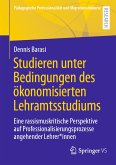Julia Mergner
Translating Student Diversity Within the German Higher Education System (eBook, PDF)
How Universities Respond to the Political Discourse on Widening Participation
31,99 €
31,99 €
inkl. MwSt.
Sofort per Download lieferbar

0 °P sammeln
31,99 €
Als Download kaufen

31,99 €
inkl. MwSt.
Sofort per Download lieferbar

0 °P sammeln
Jetzt verschenken
Alle Infos zum eBook verschenken
31,99 €
inkl. MwSt.
Sofort per Download lieferbar
Alle Infos zum eBook verschenken

0 °P sammeln
Julia Mergner
Translating Student Diversity Within the German Higher Education System (eBook, PDF)
How Universities Respond to the Political Discourse on Widening Participation
- Format: PDF
- Merkliste
- Auf die Merkliste
- Bewerten Bewerten
- Teilen
- Produkt teilen
- Produkterinnerung
- Produkterinnerung

Bitte loggen Sie sich zunächst in Ihr Kundenkonto ein oder registrieren Sie sich bei
bücher.de, um das eBook-Abo tolino select nutzen zu können.
Hier können Sie sich einloggen
Hier können Sie sich einloggen
Sie sind bereits eingeloggt. Klicken Sie auf 2. tolino select Abo, um fortzufahren.

Bitte loggen Sie sich zunächst in Ihr Kundenkonto ein oder registrieren Sie sich bei bücher.de, um das eBook-Abo tolino select nutzen zu können.
Wie reagieren Hochschulen auf die institutionelle Forderung, einer immer vielfältigeren Studierendenschaft gerecht zu werden? Aus einer organisationssoziologischen Perspektive untersucht Julia Mergner den hochschulpolitischen Diskurs zur Hochschulöffnung. Die Ergebnisse zeigen, wie unterschiedlich Hochschulen die Idee der studentischen Heterogenität in ihren lokalen Kontext übersetzen und Strategien, Strukturen und Praktiken für den Umgang legitimieren.
- Geräte: PC
- ohne Kopierschutz
- eBook Hilfe
- Größe: 3.45MB
- FamilySharing(5)
Andere Kunden interessierten sich auch für
![Qualitatives Forschen in der Erziehungswissenschaft (eBook, PDF) Qualitatives Forschen in der Erziehungswissenschaft (eBook, PDF)]() Steffen GroßkopfQualitatives Forschen in der Erziehungswissenschaft (eBook, PDF)22,99 €
Steffen GroßkopfQualitatives Forschen in der Erziehungswissenschaft (eBook, PDF)22,99 €![Diversität, Partizipation und Benachteiligung im Hochschulsystem (eBook, PDF) Diversität, Partizipation und Benachteiligung im Hochschulsystem (eBook, PDF)]() Diversität, Partizipation und Benachteiligung im Hochschulsystem (eBook, PDF)27,99 €
Diversität, Partizipation und Benachteiligung im Hochschulsystem (eBook, PDF)27,99 €- -20%11
![Hochschulorganisation und Digitalisierung (eBook, PDF) Hochschulorganisation und Digitalisierung (eBook, PDF)]() Marcel Graf-SchlattmannHochschulorganisation und Digitalisierung (eBook, PDF)59,99 €
Marcel Graf-SchlattmannHochschulorganisation und Digitalisierung (eBook, PDF)59,99 € ![Higher Education Research Methodology (eBook, PDF) Higher Education Research Methodology (eBook, PDF)]() Ben Kei DanielHigher Education Research Methodology (eBook, PDF)37,95 €
Ben Kei DanielHigher Education Research Methodology (eBook, PDF)37,95 €- -21%11
![Studieren unter Bedingungen des ökonomisierten Lehramtsstudiums (eBook, PDF) Studieren unter Bedingungen des ökonomisierten Lehramtsstudiums (eBook, PDF)]() Dennis BarasiStudieren unter Bedingungen des ökonomisierten Lehramtsstudiums (eBook, PDF)62,99 €
Dennis BarasiStudieren unter Bedingungen des ökonomisierten Lehramtsstudiums (eBook, PDF)62,99 € - -23%11
![Qualitative Forschung (eBook, PDF) Qualitative Forschung (eBook, PDF)]() Thomas BrüsemeisterQualitative Forschung (eBook, PDF)26,99 €
Thomas BrüsemeisterQualitative Forschung (eBook, PDF)26,99 € ![Rethinking Higher Education and the Crisis of Legitimation in Europe (eBook, PDF) Rethinking Higher Education and the Crisis of Legitimation in Europe (eBook, PDF)]() Ourania FilippakouRethinking Higher Education and the Crisis of Legitimation in Europe (eBook, PDF)40,95 €
Ourania FilippakouRethinking Higher Education and the Crisis of Legitimation in Europe (eBook, PDF)40,95 €-
-
- -21%11
Wie reagieren Hochschulen auf die institutionelle Forderung, einer immer vielfältigeren Studierendenschaft gerecht zu werden? Aus einer organisationssoziologischen Perspektive untersucht Julia Mergner den hochschulpolitischen Diskurs zur Hochschulöffnung. Die Ergebnisse zeigen, wie unterschiedlich Hochschulen die Idee der studentischen Heterogenität in ihren lokalen Kontext übersetzen und Strategien, Strukturen und Praktiken für den Umgang legitimieren.
Dieser Download kann aus rechtlichen Gründen nur mit Rechnungsadresse in A, B, BG, CY, CZ, D, DK, EW, E, FIN, F, GR, H, IRL, I, LT, L, LR, M, NL, PL, P, R, S, SLO, SK ausgeliefert werden.
Produktdetails
- Produktdetails
- Verlag: Budrich Academic Press
- Seitenzahl: 260
- Erscheinungstermin: 11. November 2024
- Englisch
- ISBN-13: 9783966659093
- Artikelnr.: 72091025
- Verlag: Budrich Academic Press
- Seitenzahl: 260
- Erscheinungstermin: 11. November 2024
- Englisch
- ISBN-13: 9783966659093
- Artikelnr.: 72091025
- Herstellerkennzeichnung Die Herstellerinformationen sind derzeit nicht verfügbar.
Dr. Julia Mergner is a postdoctoral researcher at the Division of Academic Teaching & Faculty Development at TU Dortmund University.
1 Frame of Study1.1 Motivation1.2 Problem Statement1.3 Research Questions and Study Objectives1.4 Approach1.5 Structure of the Thesis2 Widening Participation in the Context of German Higher Education2.1 Definitions of Student Diversity, Heterogeneity and Widening Participation2.2 Student Diversity in the German Higher Education Context2.2.1 Access Routes to Higher Education2.2.2 Socio-Demographic Characteristics2.2.3 Living Situations2.2.4 Individual Competences2.3 The German Widening Participation Agenda: Policies to Deal with Student Diversity2.3.1 Legal Framework for Widening Participation and Central Political Stakeholders2.3.2 Policy Programs and Initiatives Aimed at Student Diversity2.4 The German Widening Participation Agenda: Discourses on Widening Participation2.4.1 Prior Research on Political Discourses on Widening Participation in Higher Education2.4.2 Analysis of the German Political Discourse on Widening Participation2.5 Summary3 Theoretical Framework and Literature Review3.1 Ontological and Epistemological Assumptions3.2 Universities as a 'Special' Form of Organization3.2.1 The 'Special' Structure(s) of Universities3.2.2 The 'Special' Culture(s) of Universities3.3 Explaining Universities' Responses: Choosing an Institutional Perspective3.4 Scandinavian Institutionalism3.4.1 Translation and the Travel of Ideas3.4.2 Editing Rules and the Role of Agency3.4.3 Loose Coupling and Decoupling3.4.4 Scandinavian Institutionalism in Higher Education Research3.5 Research on Organizational Responses of Universities to Widening Participation3.5.1 Organizational Responses to Widening Participation: The Strategy Level3.5.2 Organizational Responses to Widening Participation: The Structure Level3.5.3 Organizational Responses to Widening Participation: The Action Level3.6 Explaining Local Variations in Organizational Responses to Student Diversity3.6.1 Institutional Characteristics of (German) Universities3.6.2 Diversity Paradigms and Ways of Dealing with Student Diversity3.7 Conceptualization of the Idea of Student Diversity3.8 Summary4 Research Design and Methodology4.1 Research Design4.2 Case Study Design4.3 Selection of Cases4.4 Operationalization4.5 Methods of Data Collection4.6 Data Analysis4.7 Quality Criteria in Interpretive Qualitative Research4.7.1 Inter-Subject Comprehensibility4.7.2 Triangulation 1284.7.3 Reflection on the Role of the Researcher4.8 Summary5 Case studies5.1 Case 1: The University of Hamburg5.1.1 Student profile5.1.2 QPL Initiative5.1.3 Summary5.2 Case 2: The University of Kassel5.2.1 Student profile5.2.2 QPL Initiative5.2.3 Summary5.3 Case 3: The HAW Hamburg5.3.1 Student profile5.3.2 QPL Initiative5.3.3 Summary6 Cross-case Findings: Organizational Responses of German Universities to Student Diversity6.1 Editing Rules6.1.1 Editing Rules of Context6.1.2 Editing Rules of Formulation6.1.3 Editing Rules of Logic6.1.4 Summary6.2 Retelling the Narrative of Student Diversity - The Importance of the Local Context6.2.1 University of Hamburg6.2.2 University of Kassel6.2.3 HAW Hamburg6.2.4 Summary6.3 Definitions and Organizational Practices to Deal with Student Diversity6.3.1 Prior Knowledge: Deficit Compensation6.3.2 Individual Learner Personality: Learning Community6.3.3 Special Target Groups: Starting Aid6.3.4 Learner, Writer and Student Types: Practice Space6.3.5 Individual Problems and Needs: Individual Assistance6.3.6 Mismatch Between Student and Study Program: Orientation and Guidance6.3.7 Performance of Students: Alternative Paths of Studying and Learning6.3.8 Summary7 Conclusion and Discussion7.1 Answers to Research Questions7.2 Main Contribution of the Study7.3 Limitations7.4 Avenues for Future Research7.5 Implications for Policy and Practice
1 Frame of Study1.1 Motivation1.2 Problem Statement1.3 Research Questions and Study Objectives1.4 Approach1.5 Structure of the Thesis2 Widening Participation in the Context of German Higher Education2.1 Definitions of Student Diversity, Heterogeneity and Widening Participation2.2 Student Diversity in the German Higher Education Context2.2.1 Access Routes to Higher Education2.2.2 Socio-Demographic Characteristics2.2.3 Living Situations2.2.4 Individual Competences2.3 The German Widening Participation Agenda: Policies to Deal with Student Diversity2.3.1 Legal Framework for Widening Participation and Central Political Stakeholders2.3.2 Policy Programs and Initiatives Aimed at Student Diversity2.4 The German Widening Participation Agenda: Discourses on Widening Participation2.4.1 Prior Research on Political Discourses on Widening Participation in Higher Education2.4.2 Analysis of the German Political Discourse on Widening Participation2.5 Summary3 Theoretical Framework and Literature Review3.1 Ontological and Epistemological Assumptions3.2 Universities as a 'Special' Form of Organization3.2.1 The 'Special' Structure(s) of Universities3.2.2 The 'Special' Culture(s) of Universities3.3 Explaining Universities' Responses: Choosing an Institutional Perspective3.4 Scandinavian Institutionalism3.4.1 Translation and the Travel of Ideas3.4.2 Editing Rules and the Role of Agency3.4.3 Loose Coupling and Decoupling3.4.4 Scandinavian Institutionalism in Higher Education Research3.5 Research on Organizational Responses of Universities to Widening Participation3.5.1 Organizational Responses to Widening Participation: The Strategy Level3.5.2 Organizational Responses to Widening Participation: The Structure Level3.5.3 Organizational Responses to Widening Participation: The Action Level3.6 Explaining Local Variations in Organizational Responses to Student Diversity3.6.1 Institutional Characteristics of (German) Universities3.6.2 Diversity Paradigms and Ways of Dealing with Student Diversity3.7 Conceptualization of the Idea of Student Diversity3.8 Summary4 Research Design and Methodology4.1 Research Design4.2 Case Study Design4.3 Selection of Cases4.4 Operationalization4.5 Methods of Data Collection4.6 Data Analysis4.7 Quality Criteria in Interpretive Qualitative Research4.7.1 Inter-Subject Comprehensibility4.7.2 Triangulation 1284.7.3 Reflection on the Role of the Researcher4.8 Summary5 Case studies5.1 Case 1: The University of Hamburg5.1.1 Student profile5.1.2 QPL Initiative5.1.3 Summary5.2 Case 2: The University of Kassel5.2.1 Student profile5.2.2 QPL Initiative5.2.3 Summary5.3 Case 3: The HAW Hamburg5.3.1 Student profile5.3.2 QPL Initiative5.3.3 Summary6 Cross-case Findings: Organizational Responses of German Universities to Student Diversity6.1 Editing Rules6.1.1 Editing Rules of Context6.1.2 Editing Rules of Formulation6.1.3 Editing Rules of Logic6.1.4 Summary6.2 Retelling the Narrative of Student Diversity - The Importance of the Local Context6.2.1 University of Hamburg6.2.2 University of Kassel6.2.3 HAW Hamburg6.2.4 Summary6.3 Definitions and Organizational Practices to Deal with Student Diversity6.3.1 Prior Knowledge: Deficit Compensation6.3.2 Individual Learner Personality: Learning Community6.3.3 Special Target Groups: Starting Aid6.3.4 Learner, Writer and Student Types: Practice Space6.3.5 Individual Problems and Needs: Individual Assistance6.3.6 Mismatch Between Student and Study Program: Orientation and Guidance6.3.7 Performance of Students: Alternative Paths of Studying and Learning6.3.8 Summary7 Conclusion and Discussion7.1 Answers to Research Questions7.2 Main Contribution of the Study7.3 Limitations7.4 Avenues for Future Research7.5 Implications for Policy and Practice







